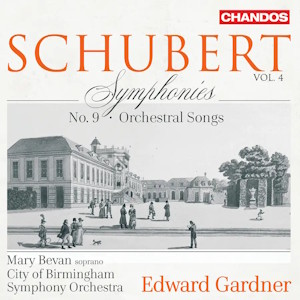
Franz Schubert (1797-1828)
Symphony No. 9 in C major, D 944 ‘Great’ (1825-1828)
Die Forelle, Op. 32, D 550 (1816/17-1821, orch. Benjamin Britten, 1942)
Romanze, D 797, No. 3b from Rosamunde (1823)
Erlkönig, Op. 1, D 328 (1815, orch. Hector Berlioz, 1860)
Geheimes, Op. 14, No. 2, D 719 (1821, orch. Johannes Brahms, 1862)
Im Abendrot, D 799 (1824/1825-1827, orch. Max Reger, 1914)
Mary Bevan (soprano)
City of Birmingham Symphony Orchestra/Edward Gardner
rec. 2024, Town Hall, Birmingham, UK
Chandos CHSA5354 SACD [67]
With the plethora of Schubert’s Ninth Symphony recordings, a new account would need something special to distinguish it from the crowd. This one does: it includes five well-known lieder in orchestral versions, mostly by other composers. Soprano Mary Bevan begins the programme. Her light, lyrical tone and warm singing are especially suitable to four of the songs, and the orchestral settings are a delight.
In Die Forelle, Britten employs two clarinets and strings, and that really suits this joyous song. The Romanze from Rosamunde here compares well with Anne Sofie von Otter’s darker mezzo voice in the complete incidental music performed by Claudio Abbado and the Chamber Orchestra of Europe (DG). Bevan is exquisite – superb dynamics and clear diction.
Edward Gardner and the CBSO play Berlioz’s version of Erlkönig with due urgency, build the music powerfully and end incisively. Bevan sings it well, even if a more dramatic soprano might be preferable. Geheimes, an intimate love song, suits Bevan’s voice perfectly. She captures the hushed, lyrical nature of the piece, and Brahms’s soft orchestration with strings and horn accompany her to the manner born. Im Abendrot, in Reger’s orchestration, is contemplative and poignant, and ravishingly rendered.
Gardner’s view of the ‘Great’ C major Symphony is fairly traditional, and none the poorer for it. His interpretation is not of unduly “heavenly length”. He eschews repeats in the last two movements, unlike Harnoncourt (Warner) or Abbado (DG), but includes the exposition repeat in the first movement. The horns are well in tune at the start, and not too loud. Gardner accelerates into the Allegro, but then maintains the quicker tempo, catching fire. This is an exciting account of the movement, well accented. The trombones at 5:00 are smooth and do not draw undue attention to themselves. Gardner draws out the coda and hammers those last notes. This creates the feeling of majesty and power, even if Schubert did not intend the slackening of tempo. Karajan and the Berlin Philharmonic in my benchmark recording on EMI are just as exciting and powerful without any slowdown there. Abbado with the Chamber Orchestra of Europe in his so-called version of the autograph score hammers home those last chords with deliberation.
Gardner sets a suitable marching tempo, not too heavy, for the second movement. The oboe solo is lovely, as are the other woodwinds, and the timpani are notable. The lyrical B section is meltingly beautiful, as good as I have heard it, with impeccable balances and dynamics. The climax contains all the necessary power without too much emphasis. The Scherzo, not heavy-handed at a tempo juste, maintains interest throughout. Much of this has to do with omitting repeats, which can make this section seem long-winded. The trio is kept in tempo and ardently played, with a fine balance between the main theme and the accompaniment. Gardner brings out the subsidiary harmony well.
The Finale begins incisively with textures clear in both the main and contrasting themes. The trombones are quite present and all the good for that. They are powerful after the 3:00 mark, with timpani to the fore. The Beethovenian section, on the other hand, relaxes like the contrasting part in the second movement. The woodwinds are exquisite and the theme is sufficiently transparent. This movement can bore with its rhythmic repetitiousness, but not here. The coda builds well, and the unison chords are terrific. There is no questionable diminuendo on the last chord, as Harnoncourt does, but Gardner does not hold it excessively long.
Overall, there is little to criticize in this account. The CBSO perform superbly, and the SACD recording, as auditioned in two channels, is stunning. Schubert scholar Brian Newbould provides the substantial notes. If the coupling appeals, do not hesitate to add this last volume of Gardner’s Schubert cycle to the many excellent recordings of the Ninth Symphony.
Leslie Wright


















